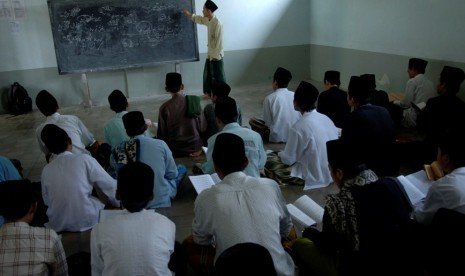Story of Unique World Mystery About Archeology of Islamic History in the pasantren hut
Pondok Pesantren (Ponpes) is still the people's choice to educate their sons and daughters. Moreover, with the number of modern-faced ponpes, more and more children of the nation who had the opportunity to go to religious education without forgetting public education.

Based on data collection ponpes 2010-2011 from the Ministry of Religious Affairs, there are 27,218 ponpes scattered throughout Indonesia. The total number of santri even reached 3,642,738 people.
Language, cottage means residence or temporary building. Pondok in Arabic is called al fundduq which means dormitory, temporary lodging place. The pesantren of the word 'santri-an' meaningful place of the santri.
Santri, according to Zamakhsyari Dhofier in Tradition Pesantren, comes from the word 'sant' which means good man and 'tri' that is like helping. Thus, santri means good humans who like to help collectively. As for Abdurrahman Mas'oed in the History and Culture of Pesantren mean santri as one who seek knowledge of Islam. Thus, pesantren refers to the place where the santri live and get a lesson.
In contrast to previous opinions, Clifford Geertz actually interpret the terminology of students of the Sanskrit 'shastri' which means Hindu scholars who are educated and good at writing. Even with CC Berg. He interpreted the santri of 'shastri', ie one who is a holy book of Hindu Religion. In other words, Western scientists tend to argue that ponpes after Islam came in Indonesia is the result of acculturation with the previous religion, Hindu-Buddhist.
However, many argue that pesantren is not related to the Hindu-Buddhist tradition but relates to the Middle East. The number of Muslim Indonesians studying to the Middle East who came home with the teaching style of the birthplace of Islam. The ministry in Masjidil Haram and Nabawi Mosque is applied by Indonesian Muslim scholars in holding the assembly when returning to Indonesia.
Marwati Djoened Poesponegoro and Nugroho Notosusanto in the Indonesian National History III: The Age of Growth and Development of Islam in Indonesia said information about the origins of pesantren institutions is very small, not even known when the institution was originally established.
There is an opinion that pesantren is a continuation of similar institutions that existed in pre-Islamic times. According to Sugarda Purbakawaca, pesantren is more like a haven of Hindu education than an Arab educational institution. The same opinion was expressed by Sutejo Brodjonegara who stated that the original pesantren education system is not Arabic, but Hindu.
"These opinions are speculative, which may be true, as there are indications that pre-Islamic hermitage remains in place some time after Java was Islamized In fact, a new hermitage continues to be established, but it is not clear whether they are educational institutions of instruction Islam goes on, "Marwati and Nugroho wrote.
From the first Dutch survey on indigenous education held in 1819 it was mentioned that actual pesantren at that time did not yet exist in Java. Pesantren-like educational institutions are reported in Priangan, Pekalongan, Rembang, Kedu, Surabaya, Madiun, and Ponorogo. In other areas there is no formal education at all, except for informal education given in private homes and mosques. The oldest pesantren that can be known the year of its founding is Tegalsari Pesantren in Ponorogo, East Java. This pesantren was founded by Sultan Paku Buwono II in 1742 as a token of thanks to Kyai Hasan Besari. Paku Buwono II also built mosques and dormitories for santri.
The Wali Sanga
According to Abdurrahman Mas'ud in Intellectual Pesantren-Religions of Religion and Tradition, the origin of pesantren relates to the presence of walisongo in the 15th-15th century AD on the island of Java. According to him, the walisongo integrate religious and secular aspects to teach Islam in the community. Thus, produced a unique educational institution. From the walisongo style of teaching, the growing ponpes continues to refer to the walisongo style.
Mediating various opinions, Haedari Amin in Future Pesantren in Challenge of Modernity and Challenges of Global Completeness says, differences of opinion does not justify one of them. Various opinions, says Amin, have a side of truth.
"These two opinions are complementary and pesantren can not be separated from Hindu elements that have been earlier in Indonesia and the elements of Middle Eastern Islam where Islam originated," he said.
Apart from the diverse origins of the pesantren, Amin said that pesantren is the root of Islamic education in Indonesia. The reason is, pesantren is considered as the method of Indonesian-born education. In its development, then born madrasah and Islamic schools. "Talking about the historical roots of Islamic education in Indonesia can not be separated from the pesantren because Pesantren is considered as the indigenous education system of Indonesia," he said.
Teaching in pesantren is almost entirely done by reading the book. There are two methods that always used ponpes, namely sorogan and companion or weton. The method of sorogan ie santri facing the teacher one by one by bringing the book that will be studied. Kiai read an Arabic sentence sentence by sentence then translated it and explained its meaning.
The bandongan method of lecture method. In this method, the santri attend the lesson by sitting around the kiai who explain the lessons in college.
mentioned that actual pesantren at that time did not yet exist in Java. Pesantren-like educational institutions are reported in Priangan, Pekalongan
Pondok in Arabic is called al fundduq which means dormitory
Good post